Kelly Olynyk, 7'0, Redshirt Junior, Center, Gonzaga
Matt Williams
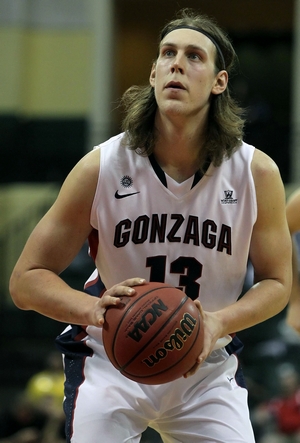
Mark Few's Gonzaga Bulldogs have gotten off to an exceptional start, earning a top-10 ranking and sporting a 15-1 record thus far. Though the program has gotten timely contributions from point guard Kevin Pangos and senior forward Elias Harris, redshirt junior Kelly Olynyk has quickly emerged as the team's leading scorer and most intriguing NBA prospect after sitting out the team's first three games for violating Gonzaga's student code of conduct.
Averaging just 12.9 minutes per-game playing behind L.A. Lakers second round pick Robert Sacre over his first two seasons in Spokane, patience has been a virtue for Olynyk. Catching the attention of scouts while gaining valuable international experience playing with Canada's junior national teams, the Kamloops native took a significant step forward when he debuted for Canada's senior national team in 2010 after his freshman year. Despite a disappointing 22nd place finish at the FIBA World Championships, Olynyk scored 33 points in 63 minutes against France and Spain, flashing intriguing potential as an inside-outside threat facing elite competition at just 19 years of age.
Seeing only a minor uptick in playing time upon returning to campus as a sophomore, Olynyk opted to sit out the 2011-2012 season, or what would have been his junior year, to retain a year of eligibility and prepare for the opportunities he'd see with Sacre out of the picture. Spending another two summers with the Canadian national team and Gonzaga's offseason program working tirelessly in the weight room, the 21 year old center is reaping the benefits of his decision this season.
The maturing Olynyk did away from the floor is evident on first glance. Redistributing the 240-pounds on his 7'0 frame and having significantly improved his conditioning, the once somewhat soft, gangly, oversized stretch-four now looks the part of a NBA center. He has gotten noticeably stronger, especially in his upper body, and while he still lacks great explosiveness, his bulked up frame hasn't had a negative impact on his excellent mobility.
Olynyk has matched his physical development with a dramatically different approach on the offensive end. Content to spot-up away from the rim and fire jump shots from the perimeter early in his career, the big man has embraced his role as post-scorer and finisher this season, doing a significant better job utilizing his size to his advantage in the paint.
What makes Olynyk unique is his versatility and skill level for a 7-footer. By no means a flashy scorer and far from a freak athlete, the inside-outside threat can use his size and soft touch to score in the post, finish his opportunities at the rim, and step out and make shots from the perimeter.
Wasting no time getting re-acclimated to a balanced Gonzaga attack that boasts terrific chemistry, Olynyk's efficiency has been nothing short of tremendous this season, as he ranks 3rd in the nation in two-point percentage at 71%. Showing a willingness to do the work before the catch and establish good position on the block, the fourth year junior doesn't have a go-to move per se, but has a knack for taking what defenders give him with his extremely high skill-level and is shooting 65% in the post (third amongst NBA prospects) according to Synergy Sports Technology, thanks in large part to his soft touch.
When he isn't operating one on one in the post, Olynyk earns himself some easy opportunities by virtue of his size and activity level off the ball. He moves well within Gonzaga's offense, cutting aggressively to the basket, plays exceptionally well off the penetration of his teammates, and provides a big target in the paint.
Away from the basket, Olynyk is still a reliable set shooter, even if he is taking jump shots at a significantly lower rate than he did early in his career. Shooting 4/12 from beyond the arc and 9/19 on jump shots overall this year, Olynyk does not leak out to the perimeter often, but is still a threat to hit from the outside. His shooting ability has been a big plus for him at the free throw line this season, where he's shooting 81%, and gives him some upside as a pick and pop threat at the next level.
When defenders give Olynyk driving lanes when he operates away from the rim, he shows unique ball handling ability for a big man. Always appearing in control when he puts in the ball on the floor, Olynyk lacks the quickness to blow by defenders in isolation situations, but he can use his dribble to set up his defender for a move in the mid-post, or dribble into a jump shot.
A versatile offensive talent, Olynyk is not without his faults. He ranks in the top 10 in turnovers amongst prospects in our top-100 per-40 minutes pace adjusted, being a bit too aggressive putting the ball on the floor when operating in the post.
With that said, scouts will have significantly more pressing questions about his rebounding ability and defensive presence. Lacking the explosiveness to rebound outside of his area or provide a presence blocking shots from the weakside, Olynyk does not make a sizeable contribution in either area relative to his peers, ranking last and fifth to last in blocks and defensive rebounds per-40 minutes pace adjusted respectively among the centers in our top-100. He does a solid job crashing the offensive glass, but must work to become a bigger factor on the defensive end.
Olynyk shows somewhat inconsistent intensity on the defensive end, though he does operate in a decent stance and moves his feet well for his size. His lack of lateral quickness and often poor awareness limit his impact on this end of the floor. He'll need to improve his intensity and show better focus to help make up for his shortcomings as best he can on this end of the floor.
One of the most pleasant surprises in the NCAA this season, Olynyk seems like a prime candidate to fill a complimentary role at the next level. His size and versatile offensive game allow him to exploit different match ups, spread the floor for his teammates, and gives him potential in the two-man game. He still has room to improve as a defender and rebounder, but players with Olynyk's profile are rare, making him someone who could easily factor into the 2013 or 2014 draft.
Laurence Bowers, 6'8, Power Forward, Missouri, Senior
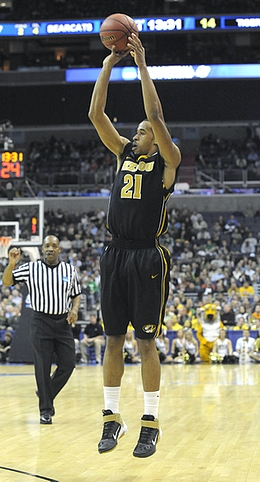
Kyle Nelson
After being named to the 2011 All Big 12 Honorable Mention as a junior, Laurence Bowers missed the entire 2011-2012 season after tearing his ACL in October of 2011. Missouri is once again poised for a deep tournament run, this time with Bowers playing an essential role at power forward. Leading the Tigers in points (16.8) and ranking second in rebounds (7) so far, Bowers has come back better than ever, and appears to be a legitimate NBA prospect still.
At 6'8 with a very long and wiry 227-pound frame, Bowers is a little smaller than the ideal power forward prospect. Although he's not an incredibly explosive athlete vertically, possibly due to not yet fully recovering from his ACL injury, he has done well to add bulk to his frame and is extremely smooth and fluid from a mobility standpoint.
13 games into the season, Bowers has returned a far more productive and efficient scorer inside and out since his injury. He is averaging 23.9 points per 40 minutes pace adjusted, which ranks him tenth amongst all power forward prospects in our database. In addition to being more productive, Bowers is also posting career highs in almost every efficiency metric, particularly impressive given how his game has evolved alongside a very dominant ball-handling point guard in Phil Pressey. As Synergy reveals, Bowers has expanded his offensive game, finding most of his offensive possessions off cuts (22.4%), as a spot-up shooter (19.4%), in transition (14.1%), out of the pick-and-roll (11.8%), via offensive rebounds (10.6%), and out of post-ups (9.4%).
What makes Bowers an interesting prospect, however, is how he has developed a shooter. Nearly, 40% of his field goal attempts are jump shots and he has proven himself competent both inside and beyond of the three-point line. Prior to his senior season, he had attempted only 38 3-pointers and made just ten; 13 games into his senior season, he has made 25 of 55 jumpers (46%), and ranking as the nation's top 3-point shooting power forward in our database. His motion is fluid and fairly quick, and his ability to hit spot-up shots behind from the three point line, off the base line out of post ups, and both guarded and open represents a skill that scouts covet in modern power forward prospects.
Bowers has also developed outstanding chemistry with point guard Phil Pressey, finding a majority of the rest of his points off of cuts to the basket and out of the pick-and-roll. Though he does not show freakish explosiveness, he is still very mobile, which combined with his solid touch around the basket and shooting ability, make him a versatile threat out of the pick-and-roll. His post game is still rudimentary, but his jump hook remains solid and his footwork is improved from his junior season. It would be nice to see him attack the basket more aggressively this season, as he rarely initiates contact thus far into his season, resulting in a paltry 3.0 free throw attempts per 40 minutes pace adjusted. While he is not the most explosive or skilled post scorer, he nonetheless possesses an interesting skill set for an NBA power forward.
Bowers' potential on the defensive end is a little more murky, primarily due to his average physical profile. He does not show great lateral quickness staying in front of quicker perimeter players off the dribble, and lacks the bulk to hold his own against stronger power forward in the post. His instincts and length allow him to compensate somewhat (as he does get a fair share of blocks and steals) at the college level, but he must continue to improve his fundamentals and intensity level here, as it will likely play a key role in the type of professional career he's able to carve out.
Furthermore, he is still a below average defensive rebounder, grabbing only 6.1 per 40 minutes pace adjusted, ranking him in the bottom third of power forward prospects in our database. While it is still early in the season, Bowers rebounded at a similarly poor rate as a sophomore and junior as well, leading credence to the notion that this is a legitimate concern.
Despite the seemingly stark improvement we've seen thus far, the jury is still out on Laurence Bowers' draft prospects at this time. While his offensive skill set certainly works in his favor, his defensive shortcomings, average physical profile, and mediocre rebounding numbers present significant questions about his NBA potential. Due to his redshirt year, he will be 23 years-old on draft night, which is another hurdle he'll have to overcome.
Regardless, Bowers is in a perfect situation to showcase himself on a team that is in pole position to make a deep run into the NCAA Tournament. NBA scouts will be watching to see if he can maintain both his productivity and efficiency into Missouri's conference schedule and the postseason. With matchups against Kentucky, Florida and others on the horizon, scouts should have plenty of opportunities to see if Bowers can produce consistently against legitimate competition. Should he continue to fare well over the rest of the season, he'll likely get a chance to showcase himself at the Portsmouth Invitational Tournament and demonstrate that he is a legit second round prospect.
Elias Harris, 6'8, Senior, Power Forward, Gonzaga
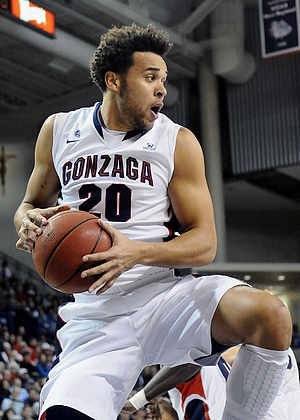
Derek Bodner
Heading into his senior season at Gonzaga, Elias Harris is a player who we have profiled extensively in the past. After a pair of underwhelming seasons that cooled the interest he earned after a surprising freshman season, seeing his numbers fall off in many key categories, Harris has rebounded to post a very good start to his senior season, both from a team and individual perspective.
Harris is producing at an all-time high, seeing his scoring rate jump from 18.0 points per 40 minutes pace adjusted to 22.4, while his Gonzaga Bulldogs have had a strong start to the season, sitting with a record of 15-1 to this point with strong wins over Kansas State, Baylor, and Oklahoma State recently.
From a skills perspective, however, Harris is largely the same player we've been profiling for quite some time. He's most comfortable creating for himself in the post, which with the departure of Robert Sacre, he's found some extra room to operate with. At 23 years old, Harris does a good job of using his physical maturity, strength, and reasonably long arms to score with regularity on the blocks at the collegiate level. He combines that with his soft hands, excellent ability to move without the ball, and deceptive quickness in the open court to create an effective option for the Gonzaga offense and provide a good impact at the collegiate level. He's also getting to the line at a much better rate so far this year, over 9 times per-40, which is by far the best of his 4 year career.
Many of the question marks about his ability to translate that to the next level, however, remain.
While it looked like Harris was beginning to make progress on his jump shot last year, he's regressed quite a bit this year, albeit on limited sample size. According to Synergy Sports Technology, Harris has only made 7 of his 28 (25%) jumpers so far this year, taking a huge step back by connecting on just 16% of his three point attempts (down from 41% last year on just 2 attempts per game), and still showing a lack of any sort of comfort in the midrange game.
From a mechanical perspective, Harris' release doesn't appear to be entirely broken, although it is a little bit deliberate and with a bit of extra movement, which could explain some of the inconsistency in the results. He's looked hesitant to take open jumpers that have been created for him in Gonzaga's free-flowing offense, which are shots he'll likely need to be comfortable taking and making at the pro level.
The bigger concern for Harris on the perimeter is his shot-creating ability, as it's still an adventure any time he has to put the ball on the floor and meets resistance. While capable of facing up and attacking opposing big men in a straight line from 17 feet, Harris is not someone who can be expected to do much ball-handling in the half-court outside of these short forays. He shows a high and loose dribble, and struggles to change directions with it if he encounters a defender, which makes him relatively ineffective when he tries to do anything too fancy off the bounce.
On the defensive side of the court Harris has many questions on which forward position he will be able to adequately defend. While Harris' body is developed and physically mature, he is somewhat undersized to play the power forward position at the next level. He also struggles to move his feet on the perimeter even for a power forward, regularly over-extending himself on the perimeter and getting caught defending with his hands because of that. While he seems to have lost some of the weight that plagued him earlier in his college career, his awareness and focus level haven't improved much at all, which makes him a regular target for opposing coaches to pick at in pick and roll situations.
On the positive side, Harris has become a solid defensive rebounder at the power forward position, pulling down 7.3 per 40 minutes this season and 8.7 last year. Harris shows good natural instincts, ability to track the ball, soft hands and a willingness to battle for position, even if his rebounding production on the offensive end is nothing to write home about.
Elias Harris is having the most productive season of his college career thus far, and depending on how the Bulldogs perform the rest of the year, will likely get his fair share of NBA looks. His effort level also appears to be more consistent, something which should help ease some of the concerns expressed over the last few years.
That being said, the main reasons for Harris' increased productivity has been an improvement on his already existing skill sets, ones that are somewhat dubious whether they will translate to the next level. Other areas that were crucial to alleviating the fears of decision makers still remain, which makes it tough to project a definitive role for Harris at the next level, a major concern for somebody who will be just a few days shy of 24 years old on draft night. With that said, it's not out of the question that someone decides to take a flyer on him in the second round or in training camp, as he's a player who seemingly knows his role and would not look out of place as the second or third power forward on a team's roster.
Juvonte Reddic, 6-9, Power Forward, Junior, VCU
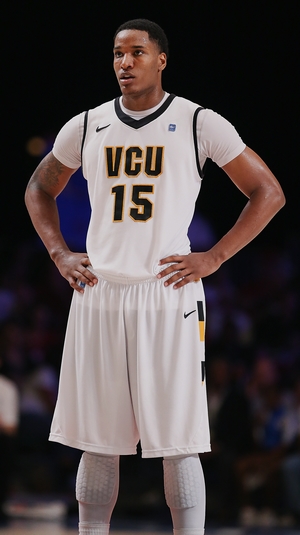
Joe Treutlein
After making solid strides his first two seasons in college, Juvonte Reddic has taken another big step forward thus far as a junior, noticeably increasing his production and efficiency across the board without an increase in minutes.
Standing 6'9 with decent length, a solid frame, and very good athleticism, Reddic has a good physical profile for a power forward, though he could still stand to fill out his frame some, specifically by adding more lower body strength. Reddic shows a good first step on the perimeter and is capable of making some very rangy strides on face-ups and post-ups, but he doesn't always elevate well around the basket in half-court situations and isn't the best at powering through contact.
On the offensive end, Reddic does most of his damage within five feet of the basket, where he scores on a variety of cuts, offensive rebounds, and post-ups. He has an active motor that helps him get open in scoring position frequently, while he shows good touch and isn't afraid to throw down a dunk when the opportunity arises. He is active on the offensive glass and shows good touch around the rim, but he does struggle to finish when bodied up against physical competition, as he's prone to getting pushed around down low.
Reddic's post-up game is still developing, but he has a few nice assets to work with already, namely a solid turnaround jumper and a very nice right-handed hook shot, possessing a very high release point. He isn't the best at backing down his man or establishing deep position, but he operates very well from the mid-post area, where his rangy strides and ability to turn into his man for a face-up make him very versatile. He shows flashes of very effective, instinctual footwork at times, but still is raw in this area overall, and relies a lot on his solid go-to moves and the athleticism and size advantages he has against a lot of his competition. Still, this is an area of his game that is progressing nicely, while he has a lot more room to grow.
Reddic's face-up game is also intriguing, but is not nearly as far along as his post-up game at this stage. While Reddic has a great first step for a big man along with solid touch and control on his drives, he doesn't possess great ball-handling and is only really dangerous on straight line drives without much help defense involved. He does, however, show decent instincts transitioning quickly from face-up to post-up game (and vice versa) when operating in the mid and high posts, but is still raw overall with his skills. He also shows flashes of a mid-range jumper (he has a respectable 23 points on 25 attempts this season according to Synergy Sports Technology), and that's definitely something to watch out for more of in the future.
Defensively, Reddic is not especially impressive in any particular area at this stage, being very raw fundamentally, much more so than on the offensive end. While he shows a good activity level and the ability to disrupt plays on the weak side using his length and athleticism, his post-up defense is below average due to a lack of court awareness and fundamentals. He frequently overplays or gets beat easily by his man, not always moving his feet laterally or by being backed down due to not getting any leverage. He shows more flashes on the perimeter, where his tools and effort allow him to contest some shots, and he probably has some potential in isolation and pick-and-roll defense as a power forward as well, but he's rarely tested at this stage, and just doesn't appear to have the fundamental base necessary to be highly effective in any regard just yet.
Reddic has managed to steadily improve his pace-adjusted rebounding each of his three years in college, but still is below average overall. Given his tools and the motor he shows in other areas of his game, this is clearly something he should be putting a higher focus on, and he definitely has considerably more potential in this area.
Looking forward, Reddic is an intriguing prospect due to his size, athleticism, and the foundations of offensive skills that he's been building, but likely needs to make some notable improvements with his lower body strength, defense, and rebounding, all of which are well within his power to do. He still has a ways to go in his development at this stage, but he's shown a steep learning curve in his three years on campus, and is someone to keep an eye on down the road, even if he doesn't find himself in serious draft discussions next season.













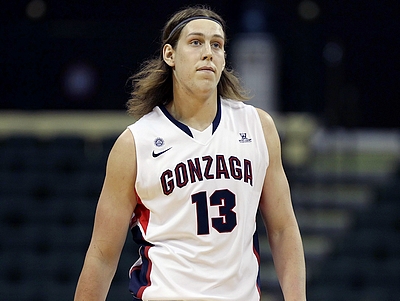




















Comments